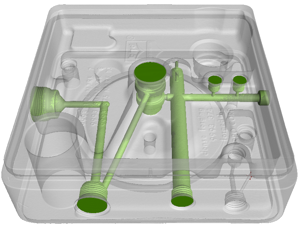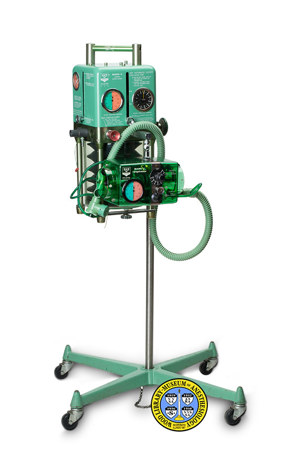How a 1960s ventilator came back to fight COVID-19
When the employees of Waygate Technologies, a Baker Hughes business, heard their services were considered “essential” to critical industries such as aviation, automotive and telecommunications, and that they would be coming in to work during the COVID-19 crisis, they were concerned. But when the opportunity arose for them to help reverse engineer an out-of-patent, proven life saver that is needed globally, immediately, and in vast numbers, they were glad their company was staying open for business.
The Bird Mark 7 is a ventilator introduced to the market in 1957 by aviator and medical Dr Forrest M. Bird. Its signature green casing was a feature of the 1960s hospital scene, and its reliable, safe, effective application to patients with respiratory problems, whose lungs needed help to stay inflated, saw it manufactured well into the 1980s. It can still be found in hospitals around the world.
“One of the biggest advantages of this ventilator is that it doesn’t require a power source,” says Scott Green, Director of Product Management, Software at 3D Systems. “This is extremely valuable for COVID-19 response efforts in emerging territories. Healthcare professionals will be able to provide valuable care, even in areas where infrastructure may not be present,” Green adds.
Breathing life into hundreds of thousands of patients
The overarching need is to produce hundreds of thousands of these already FDA-approved devices, for use throughout the world, including in the US where the Coronavirus caseload is overwhelming hospitals in cities such as New York.
David Fergenson, CEO of mass spectrometer manufacturer Livermore Instruments in Oakland, California realised that the fastest way to meet global demand for ventilators would be to create open-source specifications for production of the Bird Mark 7.
There were design references for the Bird, but Green at 3D Systems says, “From a manufacturing perspective, parts designed and built before the digital age may not completely represent available source documentation.” In other words, the trusted, working parts of Bird Mark 7 machines still in circulation may not reflect the original design specifications.
The exact form of the production-version manifold, a critical and complex part at the heart of the ventilator — was a mystery. Livermore engineers could not see inside the die-cast aluminum part to verify and replicate its specifications and construction.
Through publicizing their project and its aims, Livermore Instruments was put in touch with 3D Systems, an innovator of 3D printing that today provides digital manufacturing solutions worldwide. 3D Systems had recently formed an association — signed a memorandum of understanding and developed working relationships — with Waygate Technologies, a company renowned for developing equipment that produces high-quality computed tomography (CT) scans of industrial parts, such as the turbine blades in jet engines.
Industrial CT performs open sesame on complex parts design
Within 48 hours of shipping the part to Waygate, Livermore Instruments had received modelling of the part, produced by 3D Systems engineers using the company’s Geomagic® Design X software, from scans generated by Waygate Technologies’ phoenix v|tome|x m 3D metrology.
“We got a call from Scott on Friday a couple of weeks ago,” recalls Shana Telesz, Performance Leader for Waygate’s Customer Solutions Centers. “He told us what Livermore needed.” She greenlighted the project immediately, and waited to receive details of what was required ... along with the part.
That Sunday, Telesz was discussing COVID work arrangements with one of her engineers Brandon Miller, who had self-isolated to protect his team because his girlfriend Lindsey Mueller, an ICU nurse who is pursuing a doctorate of Nursing Practice in Adult Acute Care had volunteered to join the Coronavirus unit at her hospital in Cincinnati, Ohio. Miller, now working from home, was ultra-eager “to be part of the solution” to COVID, says Telesz, who suggested he start by steering the response to 3D Systems.
Overnight Waygate received the complex central part of the ventilator from Livermore, and by the time Telesz caught up with the project at the end of that day, scans had been sent to 3D Systems, and the data had been refined by Waygate’s Bill Hayes working the scanner, in collaboration with Miller contributing from home.
“The system our team used on this job,” says Telesz, “has one of the features unique to Waygate equipment, called scatter|correct.” This technology “detects and eliminates” the scatter radiation generated when scanning metal parts, which can blur the edges of the 3D image.
“The whole Waygate technology suite is ideal for producing clean, high-quality data on a challenging part,” says Green. He also praised the Waygate team for being “available”, “flexible”, and “communicative”.
Shared knowledge sends Birds flocking around the globe
The high-resolution mesh model — a method of representing 3D objects using polygonal shapes to define their planes, curves and edges — delivered by Waygate Technologies was critical to the subsequent online publication by Livermore of an open-source engineering package in easy-to-read STP-File format for manufacturing the Bird Mark 7. Manufacturers in different localities can apply the specifications to whatever methods they have to hand — the manifold, for example, could be die cast, sand cast or 3D printed.

Reconstructed CT image of ventilator component with internal passages (not previously visible from surface) highlighted using 3D visualization tools.
Waygate will also contribute to testing parts for an updated design of the life-saving ventilator. Having published the open-source instructions for the latest in-use Bird Mark 7, the consortium (which includes the US National Strategic Research Institute in Nebraska, and UC Davis College of Engineering), coordinated by Livermore Instruments, is now working to rapidly streamline the ventilator design for contemporary mass production by minimizing the number of component parts and optimizing for those that are easiest to make or source.
When the modified prototype has been validated, Livermore will commence mass production of the new MARK-19, as it has been named, and simultaneously disclose its new design and processes to the world — to encourage competition. Livermore Instruments and its MARK-19 consortium partners plan to begin shipping units on June 1 at a rate of 10,000 per week, and at an initial cost of $700 per unit.
In the meantime, Miller has been contacting other companies to help them understand how Waygate capabilities can contribute to producing products and equipment crucial to the cause of helping people affected by COVID-19, with the aim of helping to lighten the load on hospitals and responding organizations.
“A lot of people who have never manufactured before are stepping into that role — we can scan for quality control,” suggests Telesz. “There may be more safe, reliable older products that people are trying to reverse engineer for mass production — we can help to precisely map the structure of parts for that equipment.”







Comments